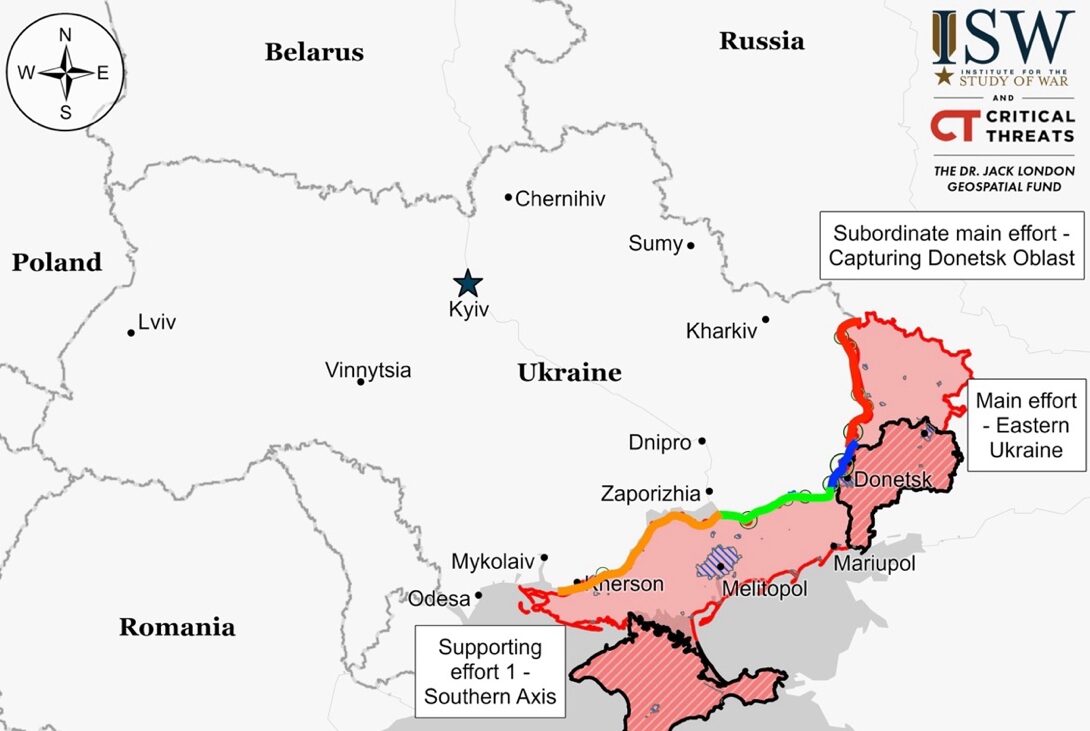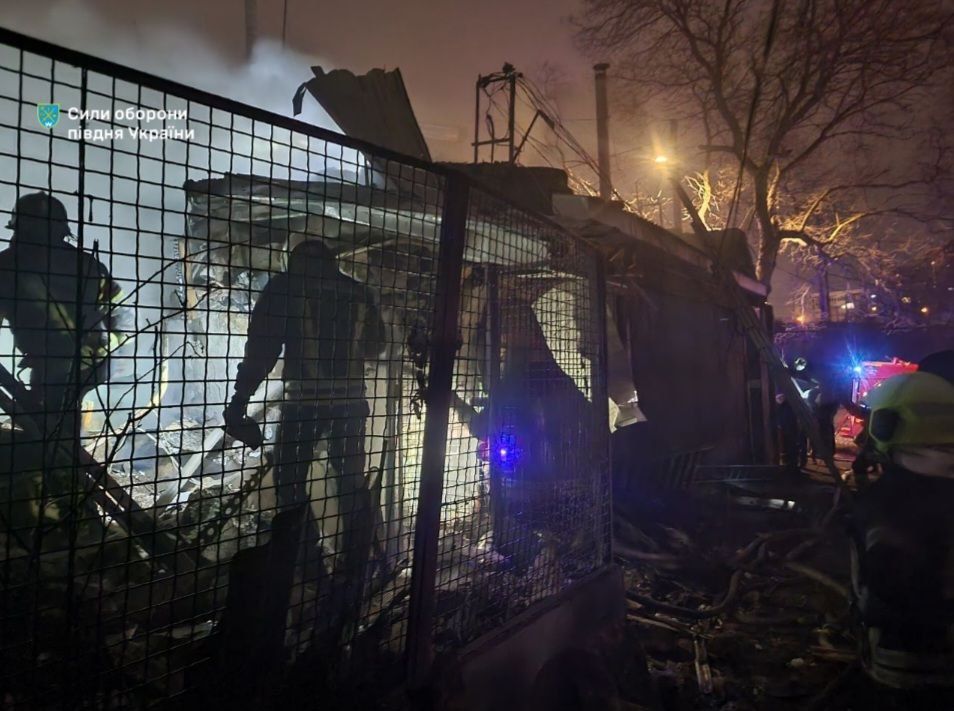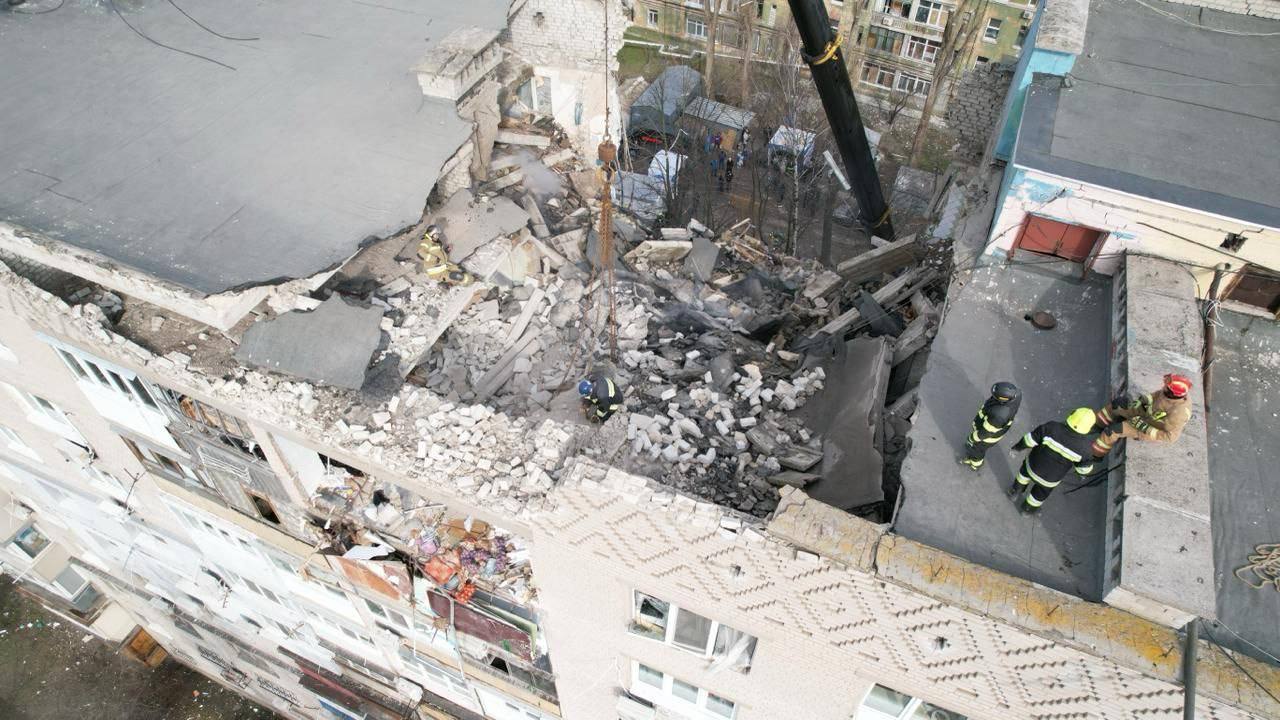Summary of the day: Ukraine downed a second Russian A-50 aircraft amidst reports of Russian self-inflicted losses due to friendly fire. Amidst material shortages, Ukraine is gearing up for future counteroffensives, while international sanctions spearheaded by the US, UK, Canada, and the EU target Russia’s military capacity. Frontline developments include Ukrainian advancements near Kreminna, contrasting with Russian gains in the same area as well as Bakhmut and Donetsk City. Simultaneously, Armenia has scaled back its involvement in the CSTO, citing unfulfilled security obligations.
Situation On The Ground And Air
Frontelligence Insight, an open-source organization in Ukraine, reports that Russian forces are utilizing previously abandoned sites near the Ukraine-Russia border for ammunition and missile storage, improving their logistical capabilities. Satellite imagery shows that a farm in Voronezh Oblast, about 50 kilometers from the border, has been repurposed since late July 2023 to hold S-300 missiles and other munitions, likely supporting Russian air defense units in the region. This repurposing of facilities since 2022 aims to strengthen Russian logistics in anticipation of countering major Ukrainian offensives in 2025. Ukraine has previously used Western-provided HIMARS to disrupt Russian logistics during key counteroffensives in 2022, and while these strikes have pushed Russian logistics back, Ukraine maintains a commitment not to use such systems against targets within Russia’s internationally recognized borders.
Ukrainian officials assess the likelihood of a Russian ground assault from Transnistria as low despite rumors of a possible annexation referendum in the pro-Russian region of Moldova. Colonel Nataliya Humenyuk and GUR Spokesperson Andriy Yusov suggest such claims are likely meant to cause socio-political unrest rather than indicate an imminent military threat. Recent missile strikes on Odesa by Russian forces are seen as pressure tactics amid Moldova’s tense situation, not as precursors to military action from Transnistria. The Institute for the Study of War (ISW) has seen no evidence of Russian forces in Transnistria preparing for significant ground operations against Ukraine, stating that the potential call for a referendum is more of a political destabilization strategy for Moldova than a direct military threat to Ukraine.

Luhansk Front – Initiative Russia
Donetsk Front – Initiative Russia
Zaporizhia Front – Initiative Russia
Kherson (Dnipro River) Front – Initiative None
Recent shifts in the conflict near Kreminna have seen both Russian and Ukrainian forces capturing territory. Ukrainian troops have regained positions east of Yampolivka, while Russian units have made slight advances near Terny. The area continues to experience intense positional fighting, particularly northwest of Kupyansk and west of Kreminna. Russian tactics near Terny reportedly involve replenishing frontline battalions with convict recruits, who face substantial equipment losses.
Russian forces have made advances in the Bakhmut region, pushing to the eastern outskirts of Ivanivske. Despite claims of further progression by Russian milbloggers, no visual confirmation has been provided. The area continues to be marked by ongoing clashes, with positional battles reported northwest and southwest of Bakhmut in various locations.
Reports indicate Russian forces made unconfirmed advances northwest of Avdiivka, with claims of progress in areas including the eastern outskirts of Sieverne and Stepove. Other assertions of Russian movements towards Orlivka, Lastochkyne, and west from Khimik in Avdiivka lack visual confirmation. The frontline remains unchanged despite ongoing positional battles in the vicinity of Avdiivka.
Russian forces have made slight advances southwest of Donetsk City, with geolocated footage showing progress south of Novomykhailivka. Claims of capturing positions near Krasnohorivka are unconfirmed. Positional fighting continues west of Donetsk City near Heorhiivka and southwest near Novomykhailivka and Pobieda.
Positional fighting has persisted in the Donetsk-Zaporizhia Oblast border region, with skirmishes reported southeast, south, and southwest of Velyka Novosilka in areas including Zolota Nyva, Novodonetske, Staromayorske, and Shevchenko. The conflict continues to involve significant military engagements across this strategically important area.
Positional battles are ongoing in western Zaporizhia Oblast, particularly around Robotyne and Verbove. Russian milbloggers note continuous fighting within Robotyne itself. The area remains a key point of contention in the broader conflict.
There’s ongoing contention over the status of a Ukrainian position in east bank Kherson Oblast, with Russian claims of capturing Krynky contradicted by Ukrainian forces. The Russian MoD asserts full control over Krynky, a claim visually unsupported due to intense Ukrainian fire preventing access. A Ukrainian soldier denies Russian control, highlighting continued Ukrainian resistance and logistical efforts despite Russian assaults. Both sides acknowledge ongoing positional fighting in the area, underlining the disputed nature of recent developments.
Human Costs Of War
In the past 24 hours, Russian attacks on civilian targets in Ukraine caused two deaths and injured at least 11 others:
- A Russian-launched drone crashed into a residential area in Odesa, causing a fire and destroying part of a building. The incident resulted in one fatality, with the victim’s wife rescued from the rubble and hospitalized in serious condition. Additionally, three other residents from a neighboring apartment sustained injuries and were taken to the hospital for treatment.
- In Dnipro, Ukraine, a man was found dead under the rubble of a nine-story apartment building struck by a Russian drone attack overnight. Emergency crews continue to search for a woman believed to have been in the building during the attack. Eight people were injured, with two hospitalized in moderate condition.
 Aftermath of a Russian drone attack on civilian targets in Odesa
Aftermath of a Russian drone attack on civilian targets in Odesa
 Aftermath of Russian drone strike on civilian apartment complex in Dnipro
Aftermath of Russian drone strike on civilian apartment complex in Dnipro
Ukraine News
Ukrainian forces have downed a Russian A-50 radar aircraft near Yeysk, Krasnodar Krai, marking the second such aircraft lost by Russia in 2024. The incident occurred over the Sea of Azov coast, with Ukrainian military confirming the shoot-down. Visual evidence from the scene indicates substantial destruction, suggesting the aircraft and crew did not survive. Local Russian reports acknowledge an aircraft crash without attributing a cause.
Overnight on February 22 to 23, Russian forces launched a barrage of 31 Shahed drones and three S-300 missiles from Primorsko-Akhtarsk, Crimea, and Donetsk Oblast. Additionally, they fired a Kh-31P anti-radar missile and two Kh-22 cruise missiles from the Black Sea. Ukrainian forces intercepted 23 Shahed drones across multiple regions, with one drone striking port infrastructure in Odesa City. Russian sources allege strikes on civilian airfields in Kharkiv Oblast and defense enterprises in Odesa and Dnipropetrovsk oblasts.
Ukrainian President Volodymyr Zelensky has indicated plans for counteroffensive operations in 2024 while facing the challenge of defending Ukrainian territory amidst material shortages. In a recent interview, Zelensky pointed out that delays in Western security assistance are creating uncertainty for operational planning. US officials project critical shortages in Ukrainian ammunition and air defense missiles by late March, with the situation worsening into the summer. These shortages may compel Ukrainian forces to conserve resources, affecting both preparation for counteroffensives and the current defense against Russian attacks. The balance between launching significant counteroffensives and maintaining defensive positions is becoming increasingly precarious due to the ongoing delays in security assistance and material constraints.
Ukrainian Main Military Intelligence Directorate (GUR) Deputy Chief Major General Vadym Skibitskyi revealed that international sanctions are deteriorating the quality of Russian missiles while Russia intensifies missile production efforts. Skibitskyi disclosed Russia’s plan to manufacture 130 missiles in February 2024, including Iskander ballistic, Kinzhal ballistic, Kalibr cruise, Kh-101 cruise, and Kh-32 cruise missiles. Additionally, he highlighted North Korea’s continued provision of missiles and artillery ammunition to Russia, likely in exchange for missile and submarine technology. Skibitskyi emphasized the necessity for Western air defense systems, such as Patriot missile defense systems, to counter ballistic missile threats. Furthermore, he disclosed the formation of a volunteer corps by the Russian Ministry of Defense (MoD), comprising 18,000 personnel, including former Wagner Group members, currently operating near Avdiivka, utilizing tactics reminiscent of the Wagner Group’s operations in Bakhmut in 2023.
Ukrainian Mobilization and Defense Industrial Base
Ukraine’s defense efforts advance as Ukroboronprom collaborates with Ceska Zbrojovka to produce CZ BREN 2 assault rifles domestically. Additionally, Defense Minister Rustem Umerov announced the acquisition of “dozens” of sanitized M113 armored personnel carriers, with plans for “hundreds” more in the pipeline.
A crowdfunding campaign on Ukrainian platform United24 raised over $7.77 million in just 36 hours for 35 maritime drones dubbed “Sea Baby.” These drones, capable of carrying explosives and featuring radar-evading materials, have proven effective in past operations. Supported by entities like Monobank and the Security Service of Ukraine, the campaign saw rapid contributions, averaging one drone funded per hour. Ukrainian military intelligence chief Kyrylo Budanov highlighted their effectiveness, signaling Ukraine’s ability to mass-produce them, with recent deployments targeting Russia’s Black Sea Fleet.
Ukraine’s Allies
The US, UK, Canada, and EU have announced significant new sanctions targeting nearly 300 Russian individuals and entities to undermine Russia’s military capabilities in Ukraine. The sanctions focus on Russia’s financial infrastructure and extend to Iran’s MODAFL for aiding Russian drone production. Additionally, third-country entities, including those in China, Serbia, and the UAE, face sanctions for their roles in supporting Russia’s efforts. The UK’s sanctions target Russia’s defense industry and oil trade operations, while Canada’s measures impact individuals and entities linked to Russia’s defense sector. The EU’s latest sanctions affect figures from Russia’s defense industry, individuals involved in sanction evasion, and those connected to the mistreatment of Ukrainian children, as well as companies from various countries that have supported Russia’s military actions.
Ukrainian and Western officials convened in Berlin to discuss aiding Ukraine in investigating and prosecuting Russian war crimes, as reported by Ukrinform. The German Justice Ministry hosted an international conference focused on supporting Ukraine’s efforts in addressing over 120,000 recorded war crime cases. Participants, including Ukraine’s Prosecutor General Andrii Kostin and officials from Germany, Poland, and the U.S., explored strategies for investigating these crimes, providing international assistance, and supporting victims.
President Volodymyr Zelensky and Danish Prime Minister Mette Frederiksen signed a 10-year security cooperation agreement in Lviv, according to Deputy Head of the Presidential Office Ihor Zhovkva. Denmark becomes the first non-G7 country to finalize such a deal, allocating 1.8 billion euros ($1.95 billion) for Ukrainian support in 2024, with a total of 8.5 billion euros ($9.2 billion) allocated from 2023 to 2028. The agreement includes provisions for fighter jet support, Navy development, demining efforts, and supply of drones, communications equipment, and radars, along with pledges to support Ukraine’s EU and NATO aspirations and maintain sanctions against Russia.
U.S. Senate Majority Leader Chuck Schumer, during a press conference in Lviv, warned of Ukraine’s risk of losing the war without American aid. Schumer highlighted the urgent need for assistance amid delays, citing the recent loss of Avdiivka. Despite the Senate’s approval of a $95 billion foreign aid bill, Republican House Speaker Mike Johnson’s reluctance to put it to a vote poses a hurdle. Schumer urged Johnson not to let politics obstruct aid, emphasizing its importance in maintaining U.S. global standing and preventing future conflicts. Fellow senators echoed Schumer’s concerns, emphasizing the potential consequences of withholding aid, including the risk of American involvement in future conflicts. They stressed the necessity of providing Ukraine with essential military equipment to bolster its defense capabilities against Russia’s invasion.
Ukrainian Railways reported another incident of agricultural products being dumped from a Ukrainian train at the Dorohusk border crossing into Poland. The protests, sparked by opposition to Ukrainian agricultural imports and the EU’s Green Deal, initially threatened to fully close the border on Feb. 20, but tensions have persisted without a complete blockade. Previous incidents of grain dumping at the border in February have raised concerns and led to calls from Ukrainian officials for Polish authorities to address the situation.
Ukraine presents a five-point plan to Poland to resolve the border blockade by Polish farmers, with Prime Minister Denys Shmyhal proposing measures to address concerns over agricultural imports and the EU’s Green Deal policies. Despite Ukrainian efforts, tensions persist as protests continue, prompting President Volodymyr Zelensky to suggest a border meeting, which Polish Prime Minister Donald Tusk deferred to a later planned meeting in March. Shmyhal’s visit to the border, accompanied by government officials, aims to advance discussions on safeguard measures and joint border controls, although Polish officials express reservations about the proposed plan’s terms.
Life in Russian Occupied Ukraine
RFE/RL revealed additional details on the forced deportation of Ukrainian children to Belarus on February 22. Approximately 2,442 children from Mariupol and Lysychansk were deported to 13 camps in Belarus by Russian and Belarusian authorities as of November 2023. Reports suggest these children undergo indoctrination into pro-Russian ideology and are stripped of their Ukrainian identities. Belarusian UNICEF, Belarusian Red Cross Head Dmytro Shevtsov, and the Talay Foundation have been implicated in facilitating these deportations since 2022. Belarusian authorities utilize the camps to expose the children to pro-Soviet propaganda and arrange meetings with Belarusian security forces.
Russian and occupation authorities are swiftly integrating Avdiivka, Donetsk Oblast into Russian governance. Chelyabinsk Oblast has pledged support for Avdiivka, and residents are reportedly receiving Russian passports, signaling the area’s formal integration into occupation structures.
Russia News
A fire broke out at the main plant of Russian steelmaker Novolipetsk Steel (NLMK) on the second anniversary of Russia’s full-scale invasion of Ukraine, as reported by the regional governor. Initial indications suggest a drone may have triggered the fire, though no attribution has been made. The plant, located around 400 kilometers from the Russia-Ukraine border, is crucial for NLMK, accounting for 80% of its steel output and serving as a significant asset for Russian billionaire Vladimir Lisin.
Russian Mobilization and Defense Industrial Base
Russian President Vladimir Putin announced that Russia has started serial production of new Zircon hypersonic missiles and received four Tu-160M strategic bombers.
Russian Allies
Ukrainian GUR Deputy Chief Major General Skibitskyi disclosed Belarus’s efforts to restore ammunition production post the removal of its stockpiles by Russian forces for use in Ukraine. Despite Belarus’s attempts, production levels remain below expectations, with Skibitskyi highlighting the absence of a significant Russian military presence in Belarus posing a direct threat to Ukraine. Concurrently, the Belarusian army is upgrading an unspecified number of Uragan multiple launch rocket systems (MLRS) combat vehicles, including improvements to engines, communications equipment, and topographical reference systems. These upgrades are underway after the vehicles were transported from the 111th Artillery Brigade near Brest, Belarus, to an undisclosed location for modernization and repairs.
Armenia has effectively halted its involvement in the CSTO, a Russia-led security alliance, with Prime Minister Nikol Pashinyan citing the group’s failure to provide promised security support. Amidst concerns over Ukraine and regional tensions, Armenia’s move reflects growing strains with Russia, although no formal exit from the CSTO has been communicated. Russian officials counter Armenia’s claims, noting its engagement with the EU over regional security matters.
Russian Narratives for Propaganda
Russian milbloggers challenge official accounts of aircraft losses, attributing them to friendly fire and highlighting flaws in military operations, a narrative diverging from claims of Ukrainian attacks and casting doubt on Russian air defense efficacy.
Source Materials
Institute for the Study of War – understandingwar.org.
The Kyiv Independent – kyivindependent.com.
